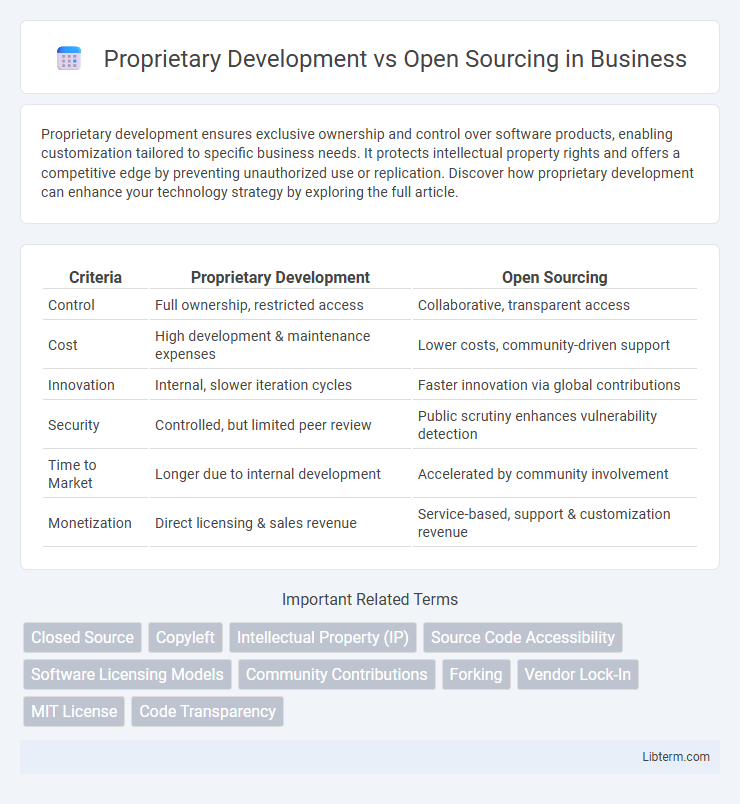Proprietary development ensures exclusive ownership and control over software products, enabling customization tailored to specific business needs. It protects intellectual property rights and offers a competitive edge by preventing unauthorized use or replication. Discover how proprietary development can enhance your technology strategy by exploring the full article.
Table of Comparison
| Criteria | Proprietary Development | Open Sourcing |
|---|---|---|
| Control | Full ownership, restricted access | Collaborative, transparent access |
| Cost | High development & maintenance expenses | Lower costs, community-driven support |
| Innovation | Internal, slower iteration cycles | Faster innovation via global contributions |
| Security | Controlled, but limited peer review | Public scrutiny enhances vulnerability detection |
| Time to Market | Longer due to internal development | Accelerated by community involvement |
| Monetization | Direct licensing & sales revenue | Service-based, support & customization revenue |
Introduction to Proprietary Development and Open Sourcing
Proprietary development involves creating software with exclusive rights held by an individual or company, restricting access to source code and controlling distribution and use. Open sourcing releases the software's source code publicly, allowing anyone to inspect, modify, and distribute it under defined licenses, fostering community collaboration and transparency. These contrasting models shape innovation, security, and business strategies within the software industry.
Defining Proprietary Software Development
Proprietary software development involves creating software with restricted access to its source code, allowing only the owning organization or individual to modify and distribute it. This model ensures exclusive control over intellectual property, which can lead to competitive advantages and revenue generation through licensing. Strict licensing agreements and legal protections safeguard the software from unauthorized use or duplication.
Understanding Open Source Software
Open source software allows developers to access, modify, and distribute source code freely, fostering collaboration and innovation across global communities. Unlike proprietary development, which restricts code to maintain control and protect intellectual property, open source encourages transparency and rapid problem-solving through collective contributions. Understanding open source software reveals its impact on accelerating software evolution, reducing costs, and enhancing security by leveraging diverse expert input.
Key Differences Between Proprietary and Open Source Models
Proprietary development restricts access to source code, granting exclusive rights to the owning company, which controls distribution, modification, and usage, ensuring security and revenue generation through licensing fees. Open source models provide public access to source code, encouraging collaboration, transparency, and community-driven improvements, enabling rapid innovation and broad adaptability. Key differences include control over intellectual property, cost structures, and the speed of updates, with proprietary software favoring protected environments and open source emphasizing shared development and flexibility.
Benefits of Proprietary Development
Proprietary development offers enhanced control over intellectual property, enabling companies to safeguard their innovations and maintain competitive advantages. It allows for focused resource allocation with customized features tailored specifically to business needs, ensuring high-quality, reliable software solutions. Furthermore, proprietary models facilitate direct revenue generation through licensing, creating sustainable financial frameworks for continued product advancement.
Advantages of Open Sourcing
Open sourcing accelerates innovation by enabling a diverse global community of developers to contribute improvements and rapidly identify bugs. It enhances transparency and security since the code is publicly accessible for scrutiny, reducing vulnerabilities and fostering trust among users. Furthermore, open sourcing lowers development costs and encourages collaboration, allowing organizations to leverage shared resources and expertise without proprietary restrictions.
Challenges and Risks of Proprietary Solutions
Proprietary development often faces challenges such as limited transparency, which can hinder external security audits and slow down vulnerability detection and patching. The reliance on a single vendor for updates and support increases the risk of vendor lock-in, potentially leading to higher costs and reduced flexibility. Furthermore, proprietary software may struggle with slower innovation cycles compared to open-source alternatives, as contributions and improvements depend solely on internal teams rather than a global community.
Potential Drawbacks of Open Source Projects
Open source projects can face challenges such as fragmented development efforts and inconsistent quality control, potentially leading to security vulnerabilities and slower feature implementation. Lack of dedicated funding may result in insufficient maintenance and support, impacting long-term viability. Intellectual property risks arise from inadvertent license violations and difficulties in protecting proprietary innovations.
Choosing the Right Approach for Your Business
Selecting between proprietary development and open sourcing hinges on your business goals, intellectual property strategy, and market positioning. Proprietary development ensures exclusive control and revenue generation from unique software, ideal for competitive differentiation and monetization. Open sourcing fosters community collaboration, accelerates innovation, and enhances transparency, benefiting businesses aiming for widespread adoption and collective improvement.
Future Trends in Software Development Models
Future trends in software development models highlight a shift towards hybrid approaches combining proprietary development with open sourcing to leverage innovation and community collaboration. Increasing adoption of open-source frameworks accelerates development cycles while maintaining proprietary components ensures competitive advantage and security. Emerging technologies such as AI-driven code generation and blockchain-based licensing are reshaping how companies manage intellectual property and contributions within these dual paradigms.
Proprietary Development Infographic

 libterm.com
libterm.com